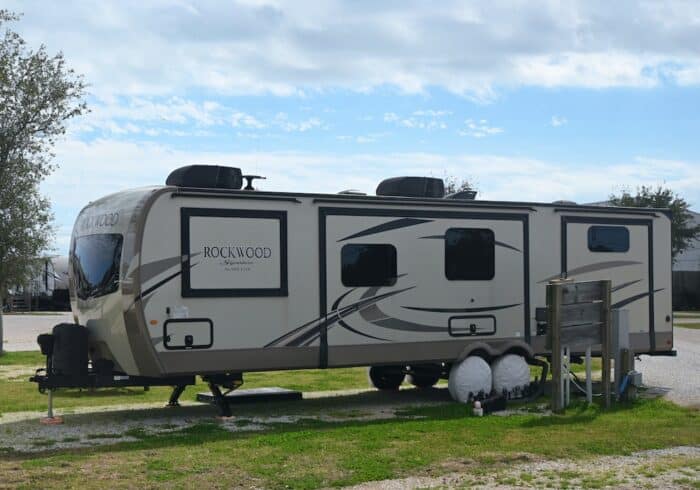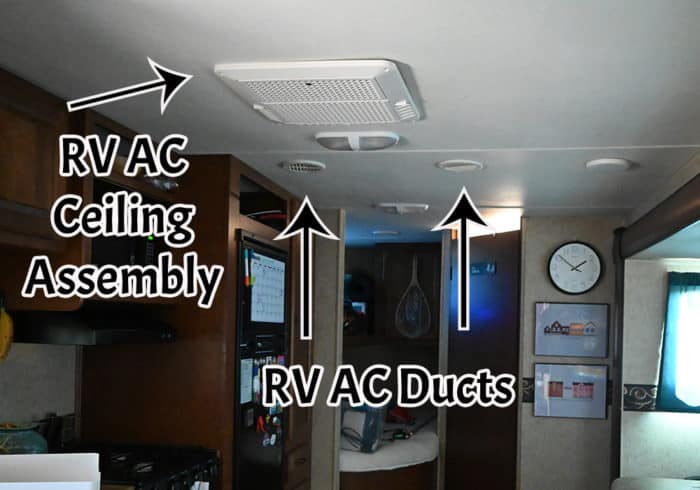Where is the RV Air Conditioner?
Most RVs, travel trailers, and 5th-wheels come with an air conditioner pre-installed on the roof. Campers can get unbelievably warm on hot summer days. A good RV AC can be a very important appliance.
Related Product: Use the Camco RV Vent Insulator (click to view on Amazon) to keep cold air inside your camper.
There are two main kinds of RV air conditioner systems, ducted and non-ducted. Ducted is for larger trailers and RVs and non-ducted is for small travel trailers, vans, and converted buses.
If you are looking to buy a new RV AC or upgrade, it’s going to be important to know if the unit already installed on your camper is 13,500 BTU or a 15,000 BTUs.
Here are a few ways you can tell what size of RV AC you have.
See Also: Best RV AC Units Reviewed (13,500 & 15,000 BTU)

How Many BTUs Is My RV Air Conditioner?
Most 30 amp RVs come with 13,500 BTU air conditioners, especially if there are multiple units on one camper.
50 amp RVs, which are usually a lot bigger in both power capacity and size, will often come with larger 15,000 BTU air conditioners.
But it’s not an exact science. You could easily have a 30 amp RV with a 15,000 BTU AC or a 50 amp RV with a 13,500 BTU AC. It depends on what the manufacturer installed on that model of camper that year.
It’s also hard to tell what size the RV AC is when you look at the air conditioner from the outside. It can take a little investigating.
Here are some common ways to check the size of an RV air conditioner.
Spec Sheet
The easiest way is to check your spec sheet to see what model they installed from the factory.
While this is the easiest way to tell, it’s not the most reliable, especially with used camper. Someone could have replaced the RV AC with a different model or size.
Unit Model Number
If you don’t have the spec sheet, or you want to be 100% certain you know the BTUs and model of your RVs AC unit, you can check the model number on the AC.
To do this, you will need to remove the AC cover, also known as the shroud, and look for the model number somewhere on the unit.
See Also: The Best Camping Gas Generators That Will Run Your RV AC
Note there may be a few different model numbers on the unit, since the various parts will sometimes also have serial numbers on them.
It might take a little searching to find the AC unit’s actual model name and number.
Check Your RV’s Amperage
You can make an educated guess based on the amperage of your RV.
If you have a 30 amp camper, your RV AC is most likely a 13,500 BTU.
If you have a 50 amp camper with one RV air conditioning unit, then it will probably be a 15,000 BTU.
Like I said earlier in this post, this isn’t a very reliable way to figure out the BTUs of an RV AC, but if you need to guess quickly, it’s something to think about.

Is It Ducted Or Non-Ducted?
The last way you can check is if your RV air conditioning system is ducted or non-ducted.
If it has ducts, there will be circular vents spread out on the ceiling of your RV. A non-ducted RV AC only shoots air out of the main vent installed directly under the AC unit.
Non-ducted systems almost always use a 13,500 BTU RV AC or smaller.
It’s a 50/50 on whether a ducted system will use the 13,500 or 15,000 BTU RV air conditioner. I have a ducted RV AC system in my travel trailer and the AC is only 13,500 BTU.
See Also: How To Easily Replace An RV AC With A Fan, Vent, or Skylight
Conclusion
In the end, it depends on what was ordered and installed in the factory.
Most of the time, a 13,500 BTU RV AC unit will be installed unless a 15,000 was specifically asked for.
The only way to be 100% certain is to get on the roof of the camper in question, remove the RV AC cover, and check the model number.
It sounds difficult, but it’s actually pretty easy to remove an RV AC shroud. There’s only 4 bolts holding it in place, and it’s really easy to put back on when you’re done.
If you’re comfortable climbing onto the roof of an RV, I recommend that method.
Related: Can You Replace A 13,500 BTU RV AC With A 15,000 BTU RV AC?
Frequently Asked Questions
What does BTU stand for?
BTU stands for British Thermal Unit. It’s a unit of measurement used to specify the amount of heat energy required to raise the temperature of one pound of water by one degree Fahrenheit.
With RV air conditioners, it’s used to show how powerful the unit is. A 15,000 BTU RV AC is the most powerful at cooling, but it also uses the most electricity.
Does a higher BTU rating mean better cooling or heating performance?
Yes, higher BTU rating means better cooling. But it also means a bigger RV AC unit, a higher power draw, and sometimes more noise.
How do I know if I need a 13,500 or 15,000 BTU RV air conditioner?
The choice between a 13,500 or 15,000 BTU RV air conditioner depends on things like the size of your RV, insulation, climate conditions, and what you prefer.
Larger RVs or those located in hot or humid climates may benefit from a higher BTU rating. If you like to keep your RV cold and you have access to shore power, the bigger the RV AC, the better.
Are there energy efficiency differences between 13,500 and 15,000 BTU units?
Higher BTU RV AC units consume more energy when starting and running, but energy efficiency can vary depending on the model and manufacturer.
Look for Energy Star-rated units or those with energy-saving features to minimize operating costs.
Also, using things like RV vent insulators (click to view on Amazon) to keep the cold air inside for longer and parking in campsites with shade helps a lot with energy consumption.
Are there noise differences between 13,500 and 15,000 BTU air conditioners?
There are slight noise differences between the two, but the biggest factor in noise difference is usually the manufacturer.
Better built RV air conditioners are quieter.
Have any questions about RV air conditioners? Leave a comment below.


The methods you mention don’t really tell you anything. What was ordered from the factory may not be what was installed (either intentionally or unintentionally). Looking at the spec sheet for the RV only tells you what the manufacturer is telling you they installed. What if they are wrong or lied? The only guaranteed way is to climb up on the roof, pull the cover off the AC unit and look at the part numbers on the AC components that are under the cover.
How many amps does a 15000 unit draw? Can I install a 15000 AC unit on a 30 amp RV?
Hi Ray,
A 15,000 BTU RV AC will draw around 13 amps when starting. It will work on a 30 amp RV but you will have to make sure no other high power appliances like the electric water heater and microwave are one when you first start it.
What size are the AC replacement filters? I’m looking to purchase them and I don’t know the size for the 13,500 BTU unit that is showed in the photos on this article. Are there different sizes? or is it one size fits all?
I have a 2021 Forest River Alpha wolf 32 foot 2 slides. In weather over 100 degrees what should the inside trailer temp difference be? I set it at 76 degrees, and during the day the temperature just climbs and the temp difference is 8 degrees. ex 102 outside, inside trailer 95. Its shuts on and off at night the way it supposed to and maintains the 76 degrees but does not turn off at all during the day. I took it in and was told everything works fine. I just want to know if anyone else has this issue.
Hi Lisa,
An RV AC should be able to cool around 15 to 20 degrees below the outside temperature, but I think the trailer might be too big for just one RV AC unit to handle.
In extra hot temperatures, the AC is already working overtime, and since RVs are poorly insulated, much of the cold air is probably escaping quickly. Especially through the gaps around the two slide outs.
Forest River should have put two AC units on your RV. But since they didn’t you are going to have to do some things to try and cool down.
If it’s true that nothing is wrong with the AC unit you should check all of the ducts to make sure they aren’t being blocked by anything.
Also, check the filters that are inside the panel that’s directly underneath the AC unit. Dirty filters can obstruct the airflow going into the RV AC which keeps it from cooling like it should.
I think the single unit is probably struggling to cool the entire RV, but it might be able to at least get the main room a little colder if you block off the ducts in the bedroom and bathroom and keep the doors closed and maybe even put something in the door gaps to keep cold air from escaping.
Adding reflective insulation to the windows to keep hot air out and cold air in is also a good idea. You could even try and better insulate the gaps around the slide outs.
Hopefully some of these suggestions help, RV manufacturers need to start adding better insulation or more AC units to help out campers who are enduring hot summer temperatures.
Do not believe what they say at dealership ,,,,our Rv was suppose to have 13,500 but we found out it was only 11,000 from dometic number,,,,,good luck getting dealership to do anything,,,,
Sorry to hear about that dealer experience. Another good reason to look at the RV AC to make sure it’s the right size.
is it okay to add more AC round ceiling vents in a 37 foot fifth wheel? The unit only came with two in living room kitchen area, one in the bathroom, and one in the bedroom. I called the manufacturer and they said that there schematic shows two in the bedroom.
Hi Greg,
I don’t see anything wrong with adding more ceiling vents if you don’t cut any roof supports and watch out for wires.